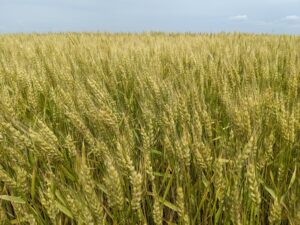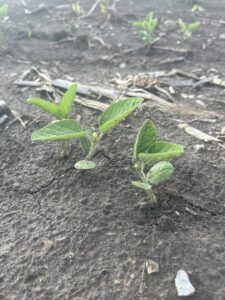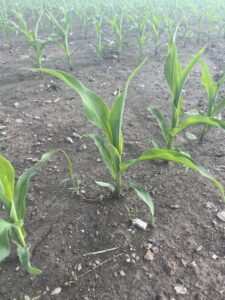Illinois Crop Update – June 7, 2024
Kathryn Seebruck – Commercial Agriculture Educator
Stephenson County
Soil Conditions: Mildly Wet (soil is wetter than normal, local vegetation is healthy)
With the significant rainfall the area saw beginning a couple weeks ago (> 2.6 inches between May 21 and 28), plus almost another inch of rain between June 1 and now, corn is beginning to show signs of N deficiency. Some fields are showing areas of stunted, light green plants, and some are exhibiting uneven emergence. This is not across the board, however, and some fields look very healthy. This week, I have seen little to no ponding in fields.
Emily Hansen – Commercial Agriculture Educator
LaSalle County
Soil Conditions: Mildly Wet (soil is wetter than normal, local vegetation is healthy)
Conditions this week were similar to last, with scattered showers and plenty of sunshine. The most mature soybeans I scouted this week were at V3, and the most mature corn was at V6. I’m starting to see more Amaranthus spp. popping up in fields.
Russ Higgins – Commercial Agriculture Educator
Grundy County
Soil Conditions: Mildly Wet (soil is wetter than normal, local vegetation is healthy)
A good growing week in NE Illinois for most. Some precipitation and several rain free days with sunshine. The earliest planted corn is V7 to V8 and earlier planted soybean is V3 to V4. Now that most planters are parked, other activities are underway. They include sidedressing nitrogen, post herbicide applications on corn, and harvesting the first cutting of hay. Several days after corn post herbicide applications have taken place, scout fields to evaluate the performance of your post herbicide application. Be wary of hard to control weeds such as marestail, with populations resistant to glyphosate in Illinois and a challenge to other chemistries once they bolt and reach a height of 6 – 8 inches. To learn about the newest in weed management plan on attending the University of Illinois 2024 Weed Science Field Research Tour on June 26th. The tour takes place at the Department of Crop Sciences field research location known as the Clem Farm, located at 1114 County Road 1200 East, Champaign. Registration begins at 8:00 a.m. and the tour will start at 9:00 a.m.

Figure 1: Treated marestail – Is it controlled?

Figure 2: Post herbicide evaluation
Meagan Diss – Commercial Agriculture Specialist
Peoria County
Soil Conditions: Mildly Wet (soil is wetter than normal, local vegetation is healthy)
Minimal planting is still happening in some areas along with some out spraying. The warmer weather has helped to dry things up but a rain on 6/5 may leave some ponding depending on individual field characteristics. Both corn and soybean growth stages are varied across the county but seeing an increase in weed pressure overall.
Talon Becker – Commercial Agriculture Specialist
Iroquois County
Soil Conditions: Near Normal
There is quite a bit of variability between fields in both corn and soybean growth stage in Iroquois County. I saw very few unplanted fields, but there were several planted within the last few days and yet to emerge. The majority of corn observed was around the V2/V3 growth stage, with a few fields closer to V5/V6. Most soybeans were at late VC or early V1, but I found a few fields with most plants at V3/V4 plants and at least a couple plants at early R1. The few wheat fields I saw looked to be progressing well into senescence with minimal lodging at this point. Soil moisture conditions were generally good, with the occasional muddy spot visible in some fields. Some uneven emergence and uneven color, particularly in corn, was observed in these wetter fields, but these areas could still recover if they don’t get hit by too much rain in the near term.

Figure 3: Corn field at V3; representative of the average corn growth stage in the county.

Figure 4: Soybean plant at early R1.

Figure 5: Wheat field senescing.
Reagan Tibbs – Commercial Agriculture Educator
Logan County
Soil Conditions: Near Normal
Brief rain showers overnight provided some much-appreciated rain for the area. Growing conditions remain steady across Logan, Menard, and Sangamon counties, with planting mostly concluded.
Nick Seiter – Extension Field Crops Entomologist
Champaign County
I have received a few reports of cutworm injury, one from black cutworm and one from variegated cutworm. This injury should wind down once corn reaches V5 or so, but continue to monitor later planted corn (especially in fields where winter annual vegetation was present close to planting time).
Dane Hunter – Commercial Agricultural Specialist
Clinton County
Soil Conditions: Moderately Wet (soil is damp, standing water may be present in low
areas, water bodies are full)
In western Clinton County, there is quite a bit of corn out of the ground, almost all of which is between V2-V4. I saw no beans past VC in the area. I drove down to Carbondale earlier this week and would venture to say that almost all of the corn in the western side of southern Illinois has been planted, and around 75% of first crop beans. South central Illinois is farther behind.

Figure 6: Soybeans at VC

Figure 7: Corn at V4. Almost all corn in the area was V2-V4





